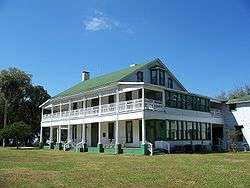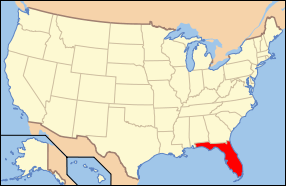Chinsegut Hill Manor House
|
Chinsegut Hill Manor House | |
 | |
  | |
| Location | Hernando County, Florida |
|---|---|
| Nearest city | Brooksville |
| Coordinates | 28°37′7″N 82°21′54″W / 28.61861°N 82.36500°WCoordinates: 28°37′7″N 82°21′54″W / 28.61861°N 82.36500°W |
| Built | 1847-1925[1] |
| Architectural style | Frame Vernacular[1] |
| NRHP reference # | 03001171[2] |
| Added to NRHP | November 21, 2003 |
| Wikimedia Commons has media related to Chinsegut Hill Manor House. |
The Chinsegut Hill Manor House (also known as Mount Airy, Snow Hill, or simply The Hill) is a United States historic site approximately five miles northeast of the city of Brooksville, Florida on Chinsegut Hill. It is located at 22495 Chinsegut Hill Road. Begun in the early 1850s, the structure has remained relatively unchanged since.
History
With the conclusion of the Second Seminole War (1835–1842) and the passing of the Armed Occupation Act on August 4, 1842, the character of Florida was transformed. In the interior of the Florida peninsula, devoid of white settlement just 10 years before, plantations were rapidly established. By the eve of statehood, planters maintained that nearly half the population and wealth of the territory was now located in central Florida.[3]
Drawn to central Florida by the opportunity offered by the Armed Occupation Act, Colonel Byrd Pearson from South Carolina laid claim to 160 acres in what is now Hernando County. He named his plantation Mount Airy and began cultivating sugarcane with the use of slave labor.[4] Pearson constructed a cabin on the site that is now the East Wing of the Manor. Pearson's cabin was completed just two years after Florida became a state.[5]
In 1851, Pearson sold the property to another South Carolinian emigrant to Florida named Francis Higgins Ederington. Between 1852 and 1854, Ederington constructed the manor house.[6]
In 1866, Colonel Russel Snow (also a South Carolinian) married Francis Ederington’s daughter Charlotte and gained control of the plantation, renaming it Snow Hill. The Snows remodeled the third-floor attic into three bedrooms and a seating area.[7]
The Robins’ Era
Possibly the most historically significant period for the Chinsegut Hill manor house occurred during the stewardship of Elizabeth, Raymond and Margaret Robins. Elizabeth purchased the home for herself and her youngest brother Raymond. But following the purchase and before they had moved in, Raymond met and married Margaret Dreier. Upon their acquisition of the property in 1904, Raymond and Elizabeth renamed the property Chinsegut Hill and set out to improve the grounds. Over the years, Raymond and Margaret added a kitchen to the east wing of the house, a widow’s walk and ventilator, the west chimney, an expanded study, and a music room. The Robins later added four bathrooms (1911), acquired additional land (1917]), added the porte-cochere (1925), and added a fifth bathroom, electricity, and a well (1933).[8]
In addition to their tremendous expansion of the property itself, the Robinses did much to improve the historical significance of the property through their involvement in politics. Raymond served as an advisor for all 7 US Presidents from Teddy Roosevelt to Franklin Delano Roosevelt. During the Russian Revolution, Raymond was appointed by President Wilson as the Commissioner of the American Red Cross Mission to Russia where he met with numerous Russian dignitaries including Alexander Kerensky, Leon Trotsky, and Vladimir Lenin. Raymond was the only American at this time to meet with Lenin and did so four times a week for five months[9] Margaret Robins, 18 year President of tne National Women's Trade Union League, dined with President Calvin Coolidge in 1923 while her husband was being considered for a cabinet post. In 1928, Raymond was present at the signing of the Pact of Paris and was called upon to help plan the presidential campaign of Herbert Hoover.[10]
The Wall Street Crash of 1929 left the Robins in financial ruin because they chose to give almost $250,000 of their money to keep the First National Bank in Brooksville from folding. Using his connections with Herbert Hoover and his administration, Raymond brokered a deal to donate the Chinsegut Hill estate to the government with the stipulation that the couple be allowed to live there until their deaths, free of property taxes.[11]
After years of illness, Margaret Robins died in 1945. Remaining active in political affairs for several years after his wife’s death, Raymond Robins died in 1954.[12] In the same year the University of Florida signed a four-year lease for the property, intending to use the site as a branch library utilizing Robins' 8,000 volumes.
Famous Guests of Chinsegut Hill
During their occupation of the Chinsegut Hill property, the Robinses entertained countless prominent guests including Soviet ambassadors, Helen Keller, Jane Addams, William Jennings Bryan, Thomas Edison, James Cash Penney, Marjorie Kinnan Rawlings, Senator Claude Pepper, and U.S. Secretary of the Interior Harold L. Ickes.[13]
Recent Events and Expansion
In 1958, the lease signed by the University of Florida expired and the university removed the books housed in the manor house, essentially abandoning the property. During the same year the University of South Florida obtained the manor house and surrounding property, signing a four-year lease as the University of Florida had previously.[14]
Under the governance of the University of South Florida, the Chinsegut Hill manor house has undergone several modifications and "modernizations” -in line with the university’s intention to utilize the site as a conference center. The university signed a 20-year lease in 1962 and has since expended vast amounts of time and money to preserve and restore the property. Alterations to the manor house include the removal of the widow’s walk and ventilator due rainwater leakage (1963), construction of several cabins (1972 & 1990’s), a dining room (1982), a classroom (1986]), a maintenance shop (1986]), and a storage shed (1990).[13]
In 1982, the U.S. Department of Agriculture transferred the title of the Chinsegut Hill property to the University of South Florida once the previous lease had expired and the university had fulfilled its obligations regarding the lease.
On November 21, 2003, Chinsegut Hill was added to the United States National Register of Historic Places through a concerted effort by members of the faculty at the University of South Florida. The University returned the property to the State of Florida in 2008 at which time the non-profit group, The Friends of Chinsegut Hill, Inc. was formed to save the property and the dilapidated Manor. The Friends oversaw a $1.5 million renovation and has been operating the Manor as a Museum since 2015. They fund their efforts by using the seven cottages onsite as rentals for retreat groups and individuals.
Controversy
In 1959, Chinsegut Hill was embroiled in the Red Scare. A plaque was commissioned by Lisa von Borowsky, family friend of the Robins and caretaker of the property, and placed on the ground near the Lenin Oak. The plaque honored the wishes of Raymond Robins to commemorate the Russian Revolution’s leader, Vladimir Lenin. In 1961, a group of Boy Scouts discovered the plaque and reported the find to the Tampa Tribune. During the ensuing media firestorm, the University of South Florida claimed to know nothing of the plaque in an attempt to disassociate the university with pro-communist innuendo.[15] Increased outcry from the media and the general public led to an inquiry in front of a grand jury on May 4, 1961. Forty-three years and three days after Margaret Robins planted the oak tree on the property, Borowsky was forced to testify on her activities as well as those of the Robins.[16]
During the 1960s, the house had many guests, from visiting researchers to USF faculty and friends. Sadly, many of the small items in the house were removed by visitors. More recently, the Chinsegut Hill manor house and the surrounding property has been plagued by the strain of age and deterioration. Many small outbuildings and a water tower have been demolished. The University of South Florida has done much to maintain the status quo of the property, but has done little to realize any meaningful efforts to restore the manor house to its previous glory.[17] Much of the university’s inaction stems from the history of slavery at the Chinsegut Hill property.[18]
External links
References
- 1 2 "Hernando County listings". Florida's History Through Its Places. Florida's Office of Cultural and Historical Programs. 2007-02-20.
- ↑ "National Register of Historical Places - Florida (FL), Hernando County". National Register of Historic Places. National Park Service. 2007-02-20.
- ↑ Tebeau, Charlton W. A History of Florida. Coral Gables: University of Miami Press, 1971.
- ↑ Stanaback, Richard J. A History of Hernando County. Brooksville, Florida: Richard J. Stanaback, 1976.
- ↑ Stanaback, Hernando, p. 12-13.
- ↑ Stanaback, Hernando, p. 295.
- ↑ Stanaback, Hernando, p. 295: Money, Eddie. “Chinsegut Chronology.” USF Library Special Collections, Tampa, Florida. n.p.
- ↑ Salzman, Neil V. Reform and Revolution: The Life and Times of Raymond Robins. Kent, Ohio: Kent State University Press, 1991.
- ↑ Salzman, Reform and Revolution, p. 191-192.
- ↑ Salzman, Reform and Revolution, p. 304, 330, 331.
- ↑ Salzman, Reform and Revolution, p. 344-345.
- ↑ Salzman, Reform and Revolution, p. 371.
- 1 2 Money, "Chinsegut Chronology," n.p.
- ↑ "CHINSEGUT HILL". Florida Historical Markers Program. Florida's Office of Cultural and Historical Programs. 2007-02-20.
- ↑ Clendinen, Dudley. “An Oak Tree for Lenin,” Floridian Magazine. June 20, 1971. p. 21-24.
- ↑ Clendien, "An Oak Tree For Lenin." p. 41.
- ↑ Hawes, Leland. "Mansion owned by USF Criticized." Tampa Tribune, 17 November 1990.
- ↑ Correia, Michael Lee. "African Americans and Chinsegut Hill: Race Relations in Hernando County, Florida, During the Jim Crow Era." Tampa Bay History (Fall/Winter 1992) : 51 - 63.
Further reading
- DeWitt, Dan. "Tour of Chinsegut spurs thoughts of what could be." Tampa Bay Times. 1 November 2016.
- DeWitt, Dan. "DeWitt: Chinsegut shows signs of fulfilling its promise." Tampa Bay Times. 5 May 2016.
- Neill, Logan "Archaeologists unearth the history of Hernando's Chinsegut Hill." Tampa Bay Times. 11 March 2014.
- Behrendt, Barbara "Friends hope to save historic Chinsegut Hill manor house in Hernando." Tampa Bay Times. 14 April 2011.
- DeWitt, Dan. "Chinsegut opening is just a 'trial run'." St. Petersburg Times. 3 June 1993.
- DeWitt, Dan. "Parting way - and parting shots." St. Petersburg Times. 9 September 2001.
- DeWitt, Dan. "Push is on to fix Manor House." St. Petersburg Times. 4 April 1990.
- DeWitt, Dan. "To the Manor Reborn." St. Petersburg Times. 24 January 1991.
- Huse, Andy. "Chinsegut Hill: From activist owners to the hands of public universities." The Oracle. 15 March 2004.
- Johnson, Neil. "Old manor steeped in history." Tampa Tribune. 29 November 1999.
- Smiljanich, Dorothy. "The spirit of Chinsegut awaits rediscovery." St. Petersburg Times. (date unknown)

